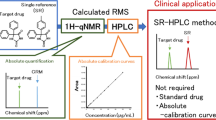Abstract
Reversed-phase separation of various pyridinium aldoximes requires a certain concentration of ion-pairing agent, as their chemical structures contain two quaternary amines in the pyridinium ring. Adequate mobile phase is scouted on the basis of retention of pyridinium aldoxime (using the graph of k′ versus concentration of an ion-pairing agent) compared to the chromatogram of the background peaks originated from the homogenate. Change in the ion-pairing agent concentration was more expressed for the elution of K-203 than that of the background peaks from the serum, brain and cerebrospinal fluid. Stability of K-203 was investigated using HPLC. Determination of K-203 in tissue samples requires homogenization using either trichloroacetic acid or perchloric acid. Fast degradation takes place at acidic pH. Adjusting pH to neutral in the possible shortest time frame helps to avoid degradation. Degradation of K-203 was easily followed by HPLC separation and monitoring the elution with an ultraviolet absorbance detector at 276 nm. Amperometric detection indicates only the decrease of K-203 content.





Similar content being viewed by others
References
Wilson IB, Ginsburg S (1955) Biochim Biophys Acta 18:168
Costa LG (2008) The basic science of poisons. In: Klaasen CD (ed) Casarett and Dull's toxicology, 7th edn. McGraw-Hill, New York, pp 883–930
Musilek K, Holas O, Jun D, Dohnal V, Gunn-Moore F, Opletalova V, Dolezal M, Kuca K (2007) Bioorg Med Chem 15:6733
Lorke DE, Hasan MY, Arafat K, Kuca K, Musilek K, Schmitt A, Petroianu GA (2008) J Appl Toxicol 28:422
Kalász H, Tekes K (2009) BenSci 1:4–7
Petroianu GA, Nurulain SM, Nagelkerke N, Shafiullah M, Kassa J, Kuca K (2007) J Appl Toxicol 27:453
Paddle BM, Dowling MH (1993) J Chromatogr 648:373
Gören AC, Bilsel G, Bilsel M, Yenisoy-Karakas S, Karakas D (2004) J Chromatogr A 1057:237
Horváth C, Melander W, Molnár I, Molnár P (1977) Anal Chem 49:2295
Laufer R, Kalász H, Musilek K, Szegi P, Darvas F, Kuca K, Tekes K (2010) Curr Org Chem 14:447
Sakurada K, Matsubara K, Shimizu K, Shioni H, Seto Y, Tsuge K, Yoshino M, Sakai I, Mukoyama H, Takatori T (2003) Neurochem Res 28:1401
Utley D (1987) J Chromatogr 396:237
Paddle BM, Dowling MH (1993) J Chromatogr 648:373
Pohjola J, Harpf M (1994) J Chromatogr A 686:350
Stenzel J, Worek F, Eyer P (2007) Biochem Pharmacol 74:1390
Cassel G, Karlsson L, Waara L, Wee Ang K, Göransson-Nyberg A (1997) Eur J Pharmacol 332:43
Lundy PM, Hill I, Lecavalir P, Hamilton MG, Vair C, Davidson C, Weatherby KL, Berger J (2005) Toxicology 208:399
Kalász H, Hasan MY, Sheen R, Kuca K, Petroianu G, Ludányi K, Gergely A, Tekes K (2006) Anal Bioanal Chem 385:1062
Tekes K, Hasan MY, Sheen R, Kuca K, Petroianu G, Ludányi K, Kalász H (2006) J Chromatogr A 1122:84
Petroianu GA, Lorke DE, Hasan MY, Adem A, Sheen R, Nurulain SM, Kalász H (2007) J Appl Toxicol 27:350
Gyenge M, Kalász H, Petroianu GA, Laufer R, Kuca K, Tekes K (2007) J Chromatogr A 1161:146
Benkő B, Laufer R, Ohmacht R (2007) Acta Chromatogr 18:61
Kalász H, Laufer R, Szegi P, Musilek K, Tekes K (2008) Acta Chromatogr 20:575
Musilek K, Jampilek J, Dohna V, Jun D, Gunn-Moore F, Dolezal M, Kuca K (2008) Anal Bioanal Chem 391:367
Singh H, Moorad-Doctor D, Ratcliff RH, Wachtel K, Castillo A, Garcia GE (2007) J Anal Toxicol 31:69
Okuno S, Sakurada K, Ohta H, Ikegaya H, Kazui Y, Akutsu T, Takatori T, Iwadate K (2008) Toxicol Appl Pharmacol 227:8
Kalász H, Szökő É, Tábi T, Petroianu GA, Lorke DE, Omar A, Alafifi S, Jasem A, Tekes K (2009) Med Chem 5:237
Houzé P, Borron SW, Scherninski F, Bousquet B, Gournel B, Baud F (2005) J Chromatogr B 814:149
Csermely T, Kalász H, Petroianu GA, Kuca K, Darvas F, Ludanyi K, Mudhafar AA, Tekes K (2008) Curr Med Chem 15:2401
Kalász H, Antal I (2006) Curr Med Chem 13:2535
Molnár L, Keserü GM, Papp Á, Gulyás Z, Darvas F (2004) Bioorg Med Chem Lett 14:851
Compudrug Inc. www.compudrug.com
Gibbon SL, Way JL (1967) J Chromatogr 26:202
Acknowledgment
Financial support of the Hungarian National Scientific Research Fund (OTKA T049492) is appreciated.
Author information
Authors and Affiliations
Corresponding author
Rights and permissions
About this article
Cite this article
Szegi, P., Kalász, H., Laufer, R. et al. Pyridinium aldoxime analysis by HPLC: the method for studies on pharmacokinetics and stability. Anal Bioanal Chem 397, 579–586 (2010). https://doi.org/10.1007/s00216-010-3635-6
Received:
Revised:
Accepted:
Published:
Issue Date:
DOI: https://doi.org/10.1007/s00216-010-3635-6




